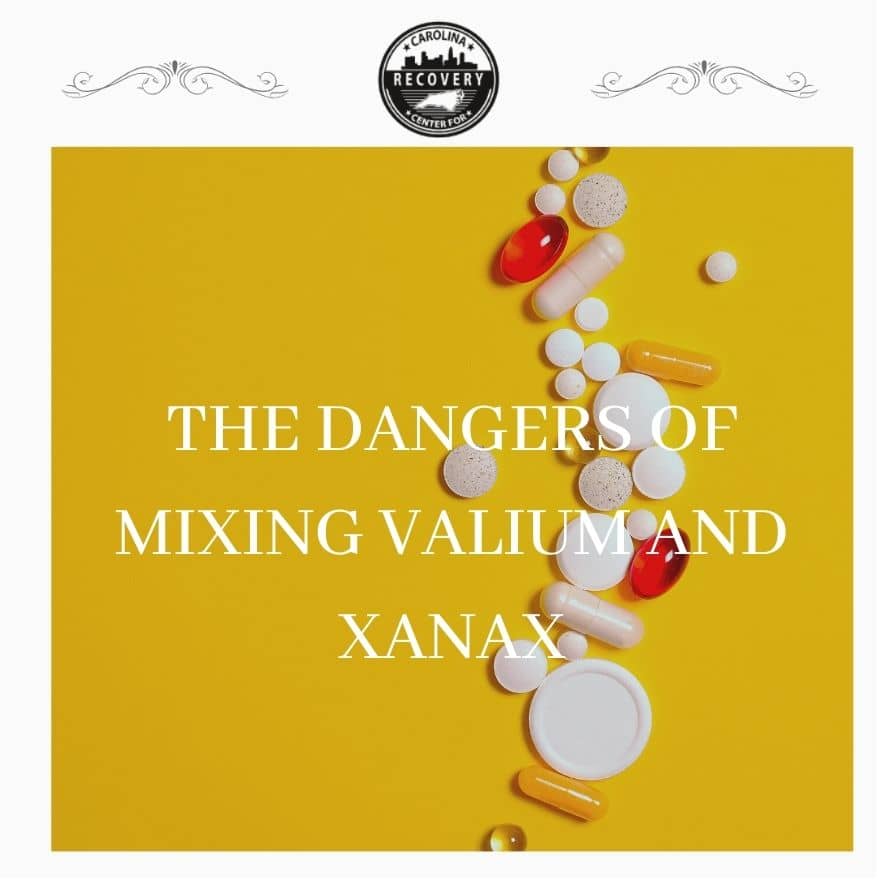The Dangers of Mixing Valium and Xanax

Medically Verified: 2/1/24
Medical Reviewer
Chief Editor

All of the information on this page has been reviewed and verified by a certified addiction professional.
Valium and Xanax are two benzodiazepine medications that are used to treat anxiety, panic disorders, and some types of seizures. Both medications are usually intended for short-term use because they are physically and mentally habit-forming.
These medications work by enhancing the reuptake of Gamma-aminobutyric acid (GABA) in the brain which decreases activity in the central nervous system.[1] This produces symptoms such as relaxation, drowsiness, dizziness, and impaired movements. When abused in high doses, benzodiazepines can suppress breathing and other cognitive functions, resulting in a life-threatening overdose.
Mixing Valium (diazepam) and Xanax (alprazolam) are particularly dangerous because both drugs work the same way. This means the sedative effects of the medications will become enhanced, thereby increasing the risk for overdose and other adverse side effects.
What is Valium (Diazepam)?
Valium is a brand name for the medication diazepam, a benzodiazepine that is used to treat anxiety, muscle spasms, and seizures. It may also be used to treat alcohol withdrawal or to provide sedation before medical surgery.
Diazepam is a Schedule IV controlled substance indicating a low to moderate potential for abuse. However, many people who take the medication long-term become physically dependent on the drug, and those who abuse it often become addicted.
Valium’s official FDA label warns, “Concomitant use of benzodiazepines and opioids may result in profound sedation, respiratory depression, coma, and death.” In order words, this medication should not be taken alongside opioids or other benzodiazepines.[2]
Diazepam Side Effects
Whether it is abused or taken as directed, Valium (diazepam) may cause side effects. These include:
- Drowsiness
- Tiredness
- Dizziness
- Fatigue
- Loss of balance
- Memory problems
- Irritability
- Restlessness
- Muscle weakness
- Nausea
- Dry mouth
- Slurred speech
- Blurry or double vision
Side effects may get worse at higher doses.
What is Xanax (Alprazolam)?
is a brand name for the medication alprazolam, a benzodiazepine that is used to treat anxiety and panic disorder. It is one of the most widely prescribed and abused benzodiazepine drugs.
Xanax, like Valium, is a schedule IV controlled substance that has the potential for misuse and addiction. Doctors often prescribe the drug on a short-term basis (usually less than two weeks) to try and prevent the formation of physical dependence.
The FDA label for Xanax has the same warning that Valium’s label does: “Concomitant use of benzodiazepines and opioids may result in profound sedation, respiratory depression, coma, and death.”[3]
Alprazolam Side Effects
Common side effects caused by alprazolam include:
- Fatigue
- Drowsiness
- Dizziness
- Slurred or slowed speech
- Headache
- Impaired memory
- Depression
- Slowed reaction time
- Loss of sex drive
- Muscle weakness
- Irritability
The risk of these side effects can be reduced by taking the medication exactly as it is prescribed by a doctor.
Dangers of Mixing Xanax and Valium
In rare cases, doctors may prescribe Valium and Xanax together, but only when there are two different conditions that need to be treated. For example, this combination may be used in the treatments of muscle spasms and insomnia, panic attacks and seizures, or insomnia and seizures. This is because Xanax is a short-acting drug, making it ideal for the treatment of anxiety or panic, while Valium is a long-acting drug making it more preferable for seizures or insomnia. Using both drugs to treat a single condition is never appropriate.
If both medications are prescribed at once, patients must take them exactly as directed. This is because mixing Valium and Xanax in high doses can significantly increase the risk for life-threatening problems like respiratory depression, sedation, or coma. Adding other depressant drugs like benzos, alcohol, or opioids to the mix can increase these risks even more.
Since both drugs are benzodiazepines and work the same way in the brain, they can enhance the side effects of each other. Common side effects of mixing Xanax and Valium include:
- Poor balance
- Depression
- Confusion
- Difficulty concentrating
- Dizziness
- Drowsiness
- Irritability
- Light-headedness
- Impaired memory
- Slurred or slowed speech
- Shortness of breath
In high doses, this drug combination can cause fainting, muscle weakness, or overdose.
Symptoms of Benzodiazepine Overdose
Benzodiazepine overdose happens when the central nervous system is depressed to the point of causing extreme drowsiness, coma, or death. In the event of a mild overdose, potential symptoms include:
- Drowsiness
- Confusion
- Lethargy
More serious overdoses involve scary, life-threatening symptoms, such as:
- Slowed reflexes
- Respiratory depression
- Loss of muscle control in the arms and legs
- Lack of balance and coordination
- Low blood pressure (hypotension)
- Bluish colored lips or fingertips
- Coma
- Death
Benzodiazepine overdose can be treated if emergency medical attention is sought quickly. Certain medications like flumazenil, a benzodiazepine antagonist, can be administered to help reverse the effects of the overdose.[4]
Find Help for Benzodiazepine Abuse and Addiction Today
Mixing Valium and Xanax together is extremely dangerous and can produce life-altering effects. If you or a loved one are addicted to benzodiazepines, it’s vital to seek help as soon as possible.
At Carolina Center for Recovery, We take a holistic approach to treating addiction, offering a variety of treatment modalities centered around identifying and resolving the underlying issues associated with the addiction. Each client enrolled in our program will receive individual attention from a therapist and psychiatrist as well as gain exposure to a multitude of traditional and alternative therapies.
Don’t wait any longer for the help you need and deserve. Call now to speak with a qualified admissions specialist.
References:
- https://www.sciencedirect.com/topics/pharmacology-toxicology-and-pharmaceutical-science/benzodiazepine-receptor
- https://www.accessdata.fda.gov/drugsatfda_docs/label/2016/013263s094lbl.pdf
- https://www.accessdata.fda.gov/drugsatfda_docs/label/2016/018276s052lbl.pdf
- https://www.ncbi.nlm.nih.gov/books/NBK470180/

